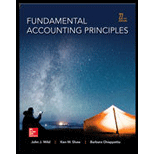
Concept explainers
Concept Introduction:
Equivalent Units of Production:
The equivalent units of production can be defined as the units which are partially completed to be counted as fully completed units based on their percentage of work done on them.
For example, the units in ending inventory are 1,000 units and 60 % completed. Thus, the equivalent units for ending inventory will be = 1,000 units X 60 % = 600 units.
Cost per equivalent unit:
Cost per equivalent unit can be defined as the costs that are incurred during the process to the equivalent units of production.
Costs assigned to Units transferred and units in ending inventory:
The costs are assigned to units transferred and units in ending inventory on the basis of equivalent units in materials and conversion and cost per units assigned.
The costs assigned to units transferred are calculated as under
The costs assigned to ending inventory are calculated as under
To assign:
Direct materials costs to the molding department’s for
1. Units transferred to package department
2. Units that remain in the molding department at month-end i.e. ending inventory
Using weighted average method
Answer to Problem 19QS
Solution:
Direct materials costs to the molding department’s for
1. Units transferred to package department = $ 25,500
2. Ending inventory = $ 3,600
Explanation of Solution
The direct materials costs assigned to units transferred and ending inventory are calculated as under
First, the equivalent units for materials will be calculated.
Given,
• Units completed and transferred = 17,000 units (i.e. 2,000 units + 18,000 units 3,000 units)
• Units in Ending inventory = 3,000 units
• Percent of Completion for ending inventory = 80 %
Equivalent units for materials is
The equivalent units for materials is = 19,400 units.
Now, the cost per equivalent unit will be calculated
Here given,
• Beginning Materials cost = $ 1,200
• Total cost added during the process = $ 27,900
• Equivalent units of production = 19,400 units
Now, the cost assigned to units transferred out and ending inventory will be calculated as under
1. For units transferred to packaging department, the cost will be assigned as under
Given,
Equivalent units for units transferred for materials = 17,000 units
Cost per equivalent unit = $ 1.50 per unit
The cost assigned to units transferred to packaging department using weighted average method = $ 25,500.
2. For units in ending inventory, the cost will be assigned as under
Given,
Equivalent units for ending inventory for materials = 2,400 units
Cost per equivalent unit = $ 1.50 per unit
The cost assigned to ending inventory using weighted average method = $ 3,600
Thus, the direct materials costs to the molding department’s units transferred to package department and units that remain in the molding department at month-end i.e. ending inventory have been assigned using weighted average method.
Want to see more full solutions like this?
Chapter 20 Solutions
Fundamental Accounting Principles -Hardcover
- What information goes on the financial system? And please give an example.arrow_forwardMit Distributors provided the following inventory-related data for the fiscal year: Purchases: $385,000 Purchase Returns and Allowances: $10,200 Purchase Discounts: $4,300 Freight In: $55,000 Beginning Inventory: $72,000 Ending Inventory: $95,500 What is the Cost of Goods Sold (COGS)?arrow_forwardanswer ? general accountingarrow_forward
- BrightTech Corp. reported the following cost of goods sold (COGS) figures over three years: • 2023: $3,800,000 • 2022: $3,500,000 • 2021: $3,000,000 If 2021 is the base year, what is the percentage increase in COGS from 2021 to 2023?arrow_forwardSun Electronics operates a periodic inventory system. At the beginning of 2022, its inventory was $95,750. During the year, inventory purchases totaled $375,000, and its ending inventory was $110,500. What was the cost of goods sold (COGS) for Sun Electronics in 2022?arrow_forwardi want to this question answer of this general accountingarrow_forward
- A clothing retailer provides the following financial data for the year. Determine the cost of goods sold (COGS): ⚫Total Sales: $800,000 • Purchases: $500,000 • Sales Returns: $30,000 • Purchases Returns: $40,000 • Opening Stock Value: $60,000 • Closing Stock Value: $70,000 Administrative Expenses: $250,000arrow_forwardsubject : general accounting questionarrow_forwardBrightTech Inc. had stockholders' equity of $1,200,000 at the beginning of June 2023. During the month, the company reported a net income of $300,000 and declared dividends of $175,000. What was BrightTech Inc.. s stockholders' equity at the end of June 2023?arrow_forward
- Question 3Footfall Manufacturing Ltd. reports the following financialinformation at the end of the current year: Net Sales $100,000 Debtor's turnover ratio (based on net sales) 2 Inventory turnover ratio 1.25 fixed assets turnover ratio 0.8 Debt to assets ratio 0.6 Net profit margin 5% gross profit margin 25% return on investments 2% Use the given information to fill out the templates for incomestatement and balance sheet given below: Income Statement of Footfall Manufacturing Ltd. for the year endingDecember 31, 20XX(in $) Sales 100,000 Cost of goods sold gross profit other expenses earnings before tax tax @ 50% Earnings after tax Balance Sheet of Footfall Manufacturing Ltd. as at December 31, 20XX(in $) Liabilities Amount Assets Amount Equity Net fixed assets long term debt 50,000 Inventory short term debt debtors cash Total Totalarrow_forwardi need correct answer of this general accounting questionarrow_forwardStockholders' equity increasedarrow_forward

 AccountingAccountingISBN:9781337272094Author:WARREN, Carl S., Reeve, James M., Duchac, Jonathan E.Publisher:Cengage Learning,
AccountingAccountingISBN:9781337272094Author:WARREN, Carl S., Reeve, James M., Duchac, Jonathan E.Publisher:Cengage Learning, Accounting Information SystemsAccountingISBN:9781337619202Author:Hall, James A.Publisher:Cengage Learning,
Accounting Information SystemsAccountingISBN:9781337619202Author:Hall, James A.Publisher:Cengage Learning, Horngren's Cost Accounting: A Managerial Emphasis...AccountingISBN:9780134475585Author:Srikant M. Datar, Madhav V. RajanPublisher:PEARSON
Horngren's Cost Accounting: A Managerial Emphasis...AccountingISBN:9780134475585Author:Srikant M. Datar, Madhav V. RajanPublisher:PEARSON Intermediate AccountingAccountingISBN:9781259722660Author:J. David Spiceland, Mark W. Nelson, Wayne M ThomasPublisher:McGraw-Hill Education
Intermediate AccountingAccountingISBN:9781259722660Author:J. David Spiceland, Mark W. Nelson, Wayne M ThomasPublisher:McGraw-Hill Education Financial and Managerial AccountingAccountingISBN:9781259726705Author:John J Wild, Ken W. Shaw, Barbara Chiappetta Fundamental Accounting PrinciplesPublisher:McGraw-Hill Education
Financial and Managerial AccountingAccountingISBN:9781259726705Author:John J Wild, Ken W. Shaw, Barbara Chiappetta Fundamental Accounting PrinciplesPublisher:McGraw-Hill Education





